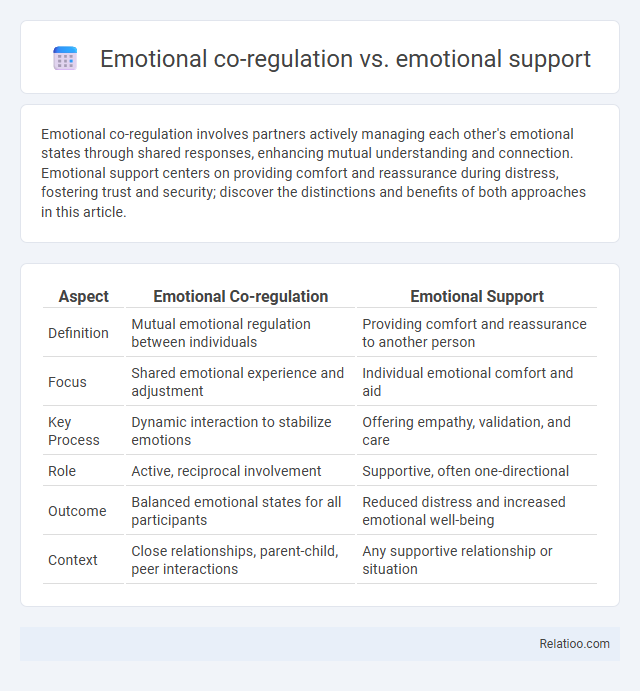Emotional co-regulation involves partners actively managing each other's emotional states through shared responses, enhancing mutual understanding and connection. Emotional support centers on providing comfort and reassurance during distress, fostering trust and security; discover the distinctions and benefits of both approaches in this article.
Table of Comparison
| Aspect | Emotional Co-regulation | Emotional Support |
|---|---|---|
| Definition | Mutual emotional regulation between individuals | Providing comfort and reassurance to another person |
| Focus | Shared emotional experience and adjustment | Individual emotional comfort and aid |
| Key Process | Dynamic interaction to stabilize emotions | Offering empathy, validation, and care |
| Role | Active, reciprocal involvement | Supportive, often one-directional |
| Outcome | Balanced emotional states for all participants | Reduced distress and increased emotional well-being |
| Context | Close relationships, parent-child, peer interactions | Any supportive relationship or situation |
Understanding Emotional Co-Regulation
Emotional co-regulation involves the dynamic process where two individuals mutually influence and manage each other's emotional states, fostering a shared emotional balance. Unlike emotional support, which is often one-sided and focuses on offering comfort or reassurance, co-regulation requires active engagement and real-time interaction to help modulate emotions together. Understanding emotional co-regulation empowers you to build stronger interpersonal connections by recognizing and participating in this reciprocal emotional process.
Defining Emotional Support
Emotional support involves providing empathy, care, and reassurance to help individuals manage their feelings and cope with stress. It differs from emotional co-regulation, which is the dynamic process where two or more individuals mutually influence and regulate each other's emotional states. Understanding emotional support emphasizes its role as a supportive response aimed at comfort, rather than the interactive and reciprocal nature of emotional co-regulation.
Key Differences Between Co-Regulation and Support
Emotional co-regulation involves a dynamic process where two individuals actively manage each other's emotional states through mutual interaction, fostering a shared emotional balance. Emotional support is more about providing comfort, reassurance, or assistance to someone experiencing emotional distress, often offered by one person to another. Understanding the key differences helps you recognize that co-regulation requires reciprocal engagement and synchronization of emotions, whereas support primarily focuses on offering help without necessarily influencing or matching the other person's emotional state.
The Science Behind Emotional Co-Regulation
Emotional co-regulation involves the dynamic interaction between individuals to manage and modulate emotions through mutual support, often observed in caregiver-child relationships and therapeutic settings. Emotional support refers to providing comfort, reassurance, and empathy to help someone manage their emotional distress, while emotional co-regulation emphasizes an active, reciprocal process where both parties influence each other's emotional states. Neuroscientific research highlights that emotional co-regulation activates brain regions responsible for social bonding and emotion regulation, such as the prefrontal cortex and limbic system, facilitating improved emotional resilience and interpersonal connection.
Benefits of Emotional Support in Relationships
Emotional support in relationships fosters a safe space for expressing feelings, reducing stress and enhancing psychological well-being. It strengthens trust and intimacy by validating emotions and promoting empathy between partners. This supportive dynamic contributes to healthier conflict resolution and greater relationship satisfaction over time.
How Emotional Co-Regulation Develops in Childhood
Emotional co-regulation in childhood develops through interactive processes between caregivers and infants, where caregivers respond sensitively to a child's emotional cues, helping them manage and understand feelings. This dynamic interaction fosters the child's growing ability to regulate emotions independently over time. Unlike emotional support, which provides comfort during distress, emotional co-regulation involves mutual regulation that is foundational for developing self-regulation skills in early development stages.
Practical Strategies for Emotional Co-Regulation
Emotional co-regulation involves interactive processes where two individuals mutually manage and modulate emotions, differing from emotional support which primarily provides comfort and reassurance without direct emotional modulation. Practical strategies for emotional co-regulation include active listening, mirroring emotions, synchronized breathing, and validating feelings to foster mutual understanding and stabilize emotional responses. These techniques enhance emotional resilience by creating a shared regulatory experience that promotes emotional balance and interpersonal connection.
When to Offer Emotional Support or Co-Regulation
Offer emotional support when someone expresses distress or seeks comfort, providing empathy and reassurance to help them manage intense feelings. Emotional co-regulation is most effective during moments of heightened emotional arousal, where guiding someone to identify and modulate their emotions collaboratively promotes self-regulation. Recognizing the individual's current state and needs determines whether direct support or active co-regulation strategies yield the best outcomes for emotional stability.
Emotional Co-Regulation in Parenting and Education
Emotional co-regulation in parenting and education involves caregivers and educators actively guiding children through managing their emotions by modeling appropriate responses and providing a supportive environment. Unlike emotional support, which primarily offers comfort during distress, co-regulation emphasizes dynamic interaction where adults help children develop self-regulation skills over time. This process promotes healthy emotional development, resilience, and improved social competence in children, laying a foundation for effective emotional management throughout life.
Enhancing Emotional Well-being Through Both Approaches
Emotional co-regulation involves mutually managing emotional states between individuals, fostering a dynamic interplay that stabilizes emotions in real-time. Emotional support provides reassurance and comfort, strengthening resilience by offering empathy and understanding during distressing moments. Combining emotional co-regulation with emotional support enhances emotional well-being through interactive regulation and compassionate validation, promoting balanced emotional health and improved relational connections.

Infographic: Emotional co-regulation vs Emotional support
 relatioo.com
relatioo.com